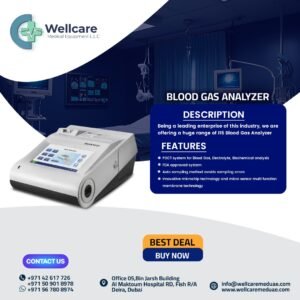Defibrillator Equipment Supplier United Arab Emirates
Well Care Medical Equipment LLC plays a crucial role as a supplier of defibrillator equipment in the United Arab Emirates (UAE), significantly impacting the nation's healthcare infrastructure and emergency response capabilities. Based in the UAE, Well Care ensures that defibrillators are available in key public and private spaces, including hospitals, airports, malls, and educational institutions. The presence of high-quality defibrillators is critical to meeting the UAE's healthcare goals, particularly as cardiac-related emergencies continue to be a leading cause of mortality across the Emirates. The company’s emphasis on supplying reliable, accessible, and user-friendly defibrillators aligns well with public health initiatives and local regulations that mandate AED (Automated External Defibrillator) availability in certain facilities, improving public safety and cardiac emergency preparedness. In addition to providing the defibrillators themselves, Well Care Medical Equipment LLC offers comprehensive support services, such as installation, training, and maintenance, ensuring that the devices remain operational and accessible at all times. Their focus on providing training to individuals and organizations fosters a culture of awareness and readiness, allowing more people to respond effectively to cardiac emergencies. This is particularly relevant in urbanized and densely populated emirates like Dubai and Abu Dhabi, where quick response times are essential for saving lives. Through such services, Well Care helps bridge the gap between technology availability and practical emergency response, empowering individuals and healthcare providers to utilize defibrillators with confidence. As the UAE continues to advance its healthcare infrastructure, Well Care Medical Equipment LLC’s role becomes even more vital. By working with both government and private sectors, the company supports the UAE's ambition to build a comprehensive, integrated healthcare network that emphasizes preventative care and quick emergency responses. Their defibrillator equipment solutions cater to a variety of settings, from high-rise buildings and hotels to remote areas, ensuring that help is never too far away in times of crisis. This dedication to health and safety across all emirates demonstrates Well Care's commitment to improving public health outcomes and making the UAE a heart-safe destination for residents and visitors alike.




The importance of defibrillator equipment in the United Arab Emirates (UAE) is increasingly recognized as the country prioritizes healthcare advancements and adopts international standards for emergency medical care. With cardiovascular diseases being one of the leading causes of death globally, the UAE has responded by integrating defibrillators across public, healthcare, and high-risk areas. This push for accessibility and awareness around defibrillator equipment addresses a critical public health need by enabling life-saving interventions in cases of sudden cardiac arrest (SCA), which can occur without warning and often demands immediate action to improve survival rates.
1. Increasing Incidence of Cardiovascular Diseases
The UAE, like many other nations, is experiencing a rise in lifestyle-related health issues, with cardiovascular diseases among the top health concerns. This trend is driven by factors including sedentary lifestyles, high rates of smoking, hypertension, obesity, and diabetes—all of which are prevalent within the region. Cardiovascular incidents such as sudden cardiac arrests require immediate intervention, as survival rates significantly decrease with each minute that passes without treatment. Defibrillators, especially automated external defibrillators (AEDs), are essential in these situations as they deliver an electric shock that can restart or normalize a patient’s heart rhythm, offering the best chance for survival in the critical first moments following a cardiac event.
2. Government Initiatives and Regulations
The UAE government has been actively promoting initiatives to enhance public safety and improve access to defibrillators. In Dubai, for instance, the government introduced the “Save a Life” campaign, which aimed to place AEDs in various public locations, making life-saving equipment readily accessible in high-traffic areas like airports, malls, and sports venues. These initiatives align with global best practices and emphasize the government’s commitment to improving emergency medical response capabilities. By making AEDs more accessible and visible, these programs significantly reduce the response time in cases of SCA, potentially saving lives that might otherwise be lost due to delayed treatment.
3. Public Education and Awareness
In addition to installing AEDs, the UAE is investing in public education campaigns to inform citizens and residents about the proper use of defibrillators and the importance of quick action during cardiac emergencies. CPR and AED training programs are offered to individuals across sectors, including schools, workplaces, and community centers. Educating the public on how to respond effectively in emergency situations empowers bystanders to act confidently, potentially bridging the gap between the onset of a cardiac arrest and the arrival of professional medical personnel. Awareness initiatives not only increase survival rates but also foster a culture of shared responsibility for public health and safety, making communities more resilient and responsive.
4. Integration into Healthcare and Emergency Response Systems
Defibrillators are integral to the UAE’s healthcare infrastructure, from hospitals and clinics to emergency response vehicles. Advanced defibrillator equipment, often used by medical professionals, comes with features like ECG monitoring, data recording, and real-time guidance, aiding healthcare providers in delivering precise and effective treatment. The integration of defibrillators into emergency response systems aligns with the UAE’s vision for high-quality, efficient healthcare services. Ambulances and first responders are equipped with professional defibrillators, which allow them to administer immediate care and stabilize patients even before reaching the hospital, thus increasing the chances of successful recovery.
5. Corporate Responsibility and Workplace Safety
Recognizing the health and safety of employees as a priority, many businesses in the UAE, particularly in high-risk industries, are installing defibrillators in workplaces. The construction, oil, and gas industries, for example, have rigorous health and safety standards and often require defibrillators on-site. Many companies now offer first-aid and AED training to their staff, allowing them to respond effectively if a cardiac emergency arises. Additionally, corporate responsibility initiatives in UAE-based organizations are focusing on providing safe working environments, with defibrillator accessibility being an essential part of workplace safety protocols. This ensures that employees have immediate access to life-saving equipment, minimizing risks associated with on-the-job emergencies.
6. Medical Tourism and International Standards
The UAE, particularly Dubai and Abu Dhabi, is positioning itself as a medical tourism hub, attracting international patients seeking high-quality healthcare services. This focus on medical tourism has compelled the healthcare sector to adopt advanced medical technology and adhere to international standards in emergency medical care. The availability of defibrillator equipment in hospitals, clinics, and public areas ensures that medical facilities are well-prepared to handle emergencies for both residents and visitors. By implementing these life-saving measures, the UAE strengthens its reputation as a safe destination for medical treatment and wellness, providing reassurance to international patients and contributing to the growth of the healthcare industry.
7. Technological Advancements in Defibrillators
With ongoing advancements in medical technology, modern defibrillators have become more user-friendly and effective, enhancing their importance in the UAE’s healthcare system. Automated external defibrillators (AEDs) are now designed with intuitive interfaces, voice-guided instructions, and feedback systems that guide users through each step of the process. These innovations make it easier for untrained individuals to administer care confidently and accurately. Additionally, some AEDs are equipped with connectivity features that allow emergency services to be automatically notified when a defibrillator is used, helping to coordinate rapid medical response. The UAE’s adoption of these advanced defibrillators demonstrates a commitment to cutting-edge healthcare solutions that support both professional responders and the general public in emergency scenarios.
8. Reducing Mortality Rates and Improving Health Outcomes
The UAE’s emphasis on defibrillator accessibility and training directly impacts public health by contributing to reduced mortality rates from cardiac-related incidents. Early defibrillation, especially within the critical first few minutes of a cardiac arrest, is associated with significantly higher survival rates and improved patient outcomes. By reducing the time to treatment, the presence of defibrillators in accessible locations plays a vital role in improving the chances of survival and recovery for cardiac arrest victims. This investment in emergency care infrastructure reflects the UAE’s commitment to public health and reinforces the healthcare system’s capacity to manage emergencies effectively.
Defibrillator equipment plays a vital role in the UAE’s healthcare strategy, addressing the growing need for cardiac emergency preparedness and enhancing public safety. With cardiovascular diseases posing a major health risk, the strategic placement of defibrillators across public areas, workplaces, and healthcare facilities, along with comprehensive public training, allows for timely intervention, ultimately saving lives. The UAE’s focus on incorporating advanced defibrillation technology, coupled with its investment in awareness and education, not only meets international standards but also positions the country as a leader in emergency medical response. Through these measures, the UAE ensures that residents and visitors alike have access to critical, life-saving equipment when they need it most.
Are the defibrillators supplied by Well Care compliant with international standards?
Yes, all defibrillators provided by Well Care are sourced from globally recognized manufacturers and comply with international healthcare and safety standards.
